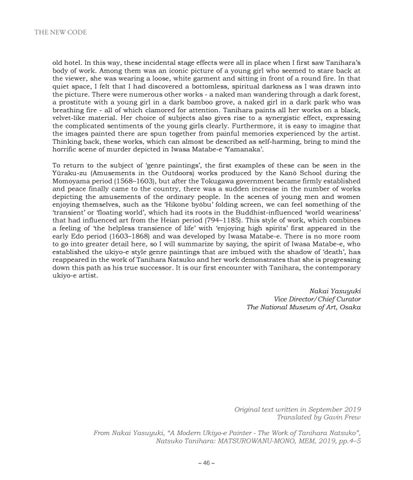THE NEW CODE
old hotel. In this way, these incidental stage effects were all in place when I first saw Tanihara’s body of work. Among them was an iconic picture of a young girl who seemed to stare back at the viewer, she was wearing a loose, white garment and sitting in front of a round fire. In that quiet space, I felt that I had discovered a bottomless, spiritual darkness as I was drawn into the picture. There were numerous other works - a naked man wandering through a dark forest, a prostitute with a young girl in a dark bamboo grove, a naked girl in a dark park who was breathing fire - all of which clamored for attention. Tanihara paints all her works on a black, velvet-like material. Her choice of subjects also gives rise to a synergistic effect, expressing the complicated sentiments of the young girls clearly. Furthermore, it is easy to imagine that the images painted there are spun together from painful memories experienced by the artist. Thinking back, these works, which can almost be described as self-harming, bring to mind the horrific scene of murder depicted in Iwasa Matabe-e ‘Yamanaka’. To return to the subject of ‘genre paintings’, the first examples of these can be seen in the Yūraku-zu (Amusements in the Outdoors) works produced by the Kanō School during the Momoyama period (1568–1603), but after the Tokugawa government became firmly established and peace finally came to the country, there was a sudden increase in the number of works depicting the amusements of the ordinary people. In the scenes of young men and women enjoying themselves, such as the ‘Hikone byōbu’ folding screen, we can feel something of the ‘transient’ or ‘floating world’, which had its roots in the Buddhist-influenced ‘world weariness’ that had influenced art from the Heian period (794–1185). This style of work, which combines a feeling of ‘the helpless transience of life’ with ‘enjoying high spirits’ first appeared in the early Edo period (1603–1868) and was developed by Iwasa Matabe-e. There is no more room to go into greater detail here, so I will summarize by saying, the spirit of Iwasa Matabe-e, who established the ukiyo-e style genre paintings that are imbued with the shadow of ‘death’, has reappeared in the work of Tanihara Natsuko and her work demonstrates that she is progressing down this path as his true successor. It is our first encounter with Tanihara, the contemporary ukiyo-e artist. Nakai Yasuyuki Vice Director/Chief Curator The National Museum of Art, Osaka
Original text written in September 2019 Translated by Gavin Frew From Nakai Yasuyuki, “A Modern Ukiyo-e Painter - The Work of Tanihara Natsuko”, Natsuko Tanihara: MATSUROWANU-MONO, MEM, 2019, pp.4–5 – 46 –






